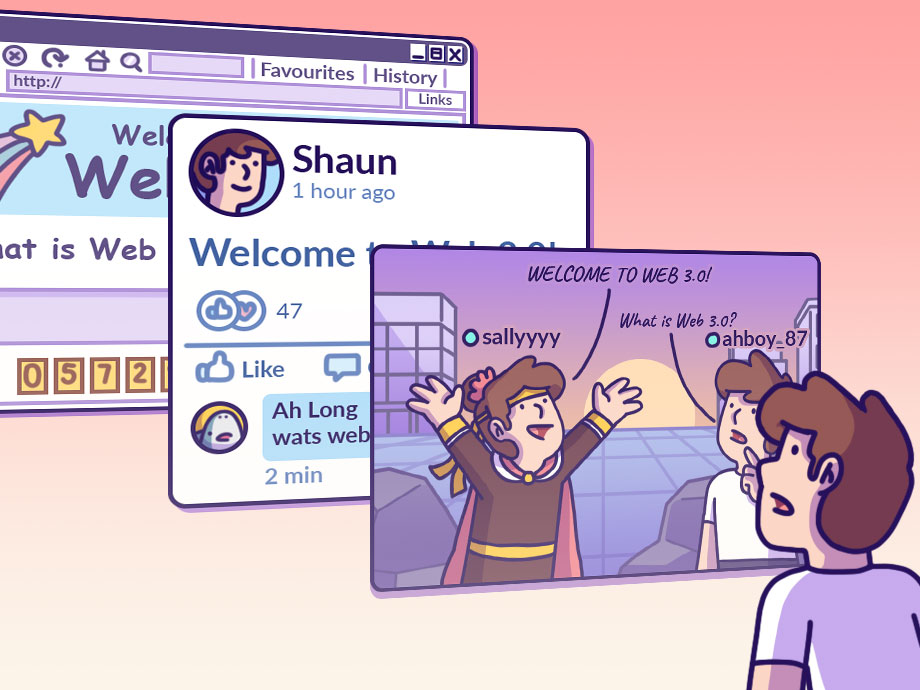Web3 | Article
What Exactly is the Metaverse?
by The Simple Sum Team | 11 Sep 2022

When Facebook rebranded itself as Meta, that was probably when most of us first came into contact with the term “metaverse”.
But the term “metaverse” was in fact coined by author Neal Stephenson in his 1992 novel Snow Crash. He envisioned a virtually shared space that fused physical reality with virtual worlds in which users could interact using avatars or digital personas. Taken from the prefix “meta” – meaning beyond or transcending – the idea proposes the digitisation of our physical lives such that we work, learn, and socialise within a 3D virtual reality.
This migration to cyberspace is well underway. This has been intensified by the restriction of physical movement in public spaces during the COVID pandemic, and the resultant increase in reliance on the internet for education, industry, art, and social activities.
The metaverse promises to transform social media’s “likes” and Zoom’s 2D-grid meeting rooms with interactive and immersive worlds that exist as a persistent shared realm and perceived virtual universe.
Technological advancements in the space of augmented reality (AR), virtual reality (VR), artificial intelligence (AI), and blockchain are driving the transition from our current usage of the internet to the metaverse. The metaverse integrates all these technologies so that interactions between the real and virtual worlds are as tight and seamless as possible.
Meta: Facebook’s bet on the metaverse
Facebook’s rebranding as Meta is Mark Zuckerberg’s most recent commitment towards developing a “metaverse company” following their launch of VR platform Horizon and their $10 billion investment in Reality Labs – an AR and VR design hub. Amazon, Alphabet (Google), and Microsoft have all expressed interest in creating a metaverse and – given the irretrievable costs involved in developing a metaverse system – these companies are perhaps the best placed to actualise the digital universe.
Where the blockchain fits in
The blockchain is literally the building block of the metaverse and can be used to ensure its security and operation. Aside from its obvious application in digital currencies, blockchain technology is necessary for storing user generated data, which in the metaverse would amount to an inconceivable figure. As opposed to traditional centralised storage systems (e.g. cloud-based storage) where users’ data is commodified outside of their purview, a distributive data management system allows users to control their own data and provides them with transparency with respect to how their data is used. What’s more, the blockchain can guarantee the security of shared data and introduce smart contracts and access control to track the data-accessing behaviour of all users.
Related
The applications of metaverse
1. Gaming
As one of the more obvious and popular applications of the metaverse, metaverse technology will allow players to interact with other players in a single virtual environment.
This means:
- A fully-fledged social environment within a game where every player can stay connected.
- The ability to implement digital currencies (cryptocurrencies) that players can earn within a metaverse environment.
2. Travel and tourism
Another high-potential application of the metaverse is in the travel and tourism industry. This would mean the re-creation of tourist attractions and locations in the virtual world, enabling tourists to experience these attractions/locations in a 3D virtual environment.
3. Learning and education
A promising field with respect to the application of the metaverse, students can watch or carry out field experiments virtually. They’ll also be able to take virtual field trips (e.g. in a virtual spaceship for astronomy classes) from the comfort of their home or classroom.
4. Remote working
With COVID becoming endemic, remote working has become something of a necessity. Hence, the metaverse and VR technology can help to bridge the physical divide through the use of virtual environments for meetings. Such technology can also be used in the area of experiential training for roles that are more “hands-on”.
5. Real estate
Realtors ad property agents will not need to conduct in-person property tours as properties can now be viewed and experienced in the metaverse. Moreover, property tours can be conducted with multiple clients within the same session.
6. Healthcare
One of the most promising applications of the metaverse is that training for surgical procedures can be conducted virtually. Beyond surgical training, doctors (General Practitioners) can now conduct consultations remotely through virtual 3D clinics, lessening the anxiety of patients and decreasing the preventing the spread of communicable diseases.
7. Social/Digital media
The metaverse will take social media to another level – enabling virtual representations of individuals (avatars) to interact in a virtual space. Moreover, brands can make use of this virtual space to advertise/launch products and allow potential buyers to “interact” with these products before purchase.















